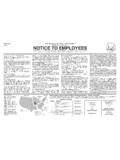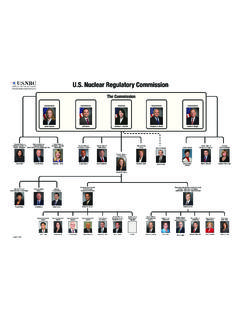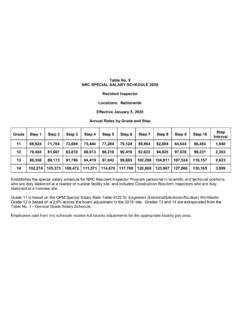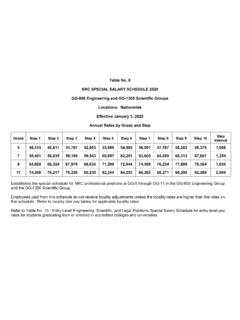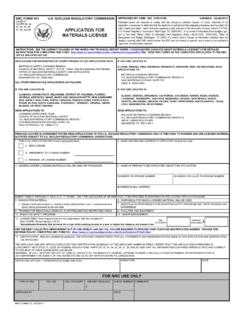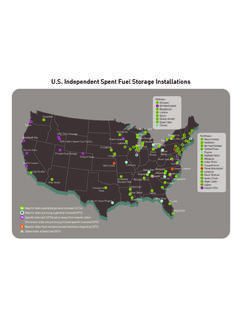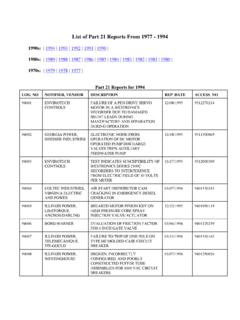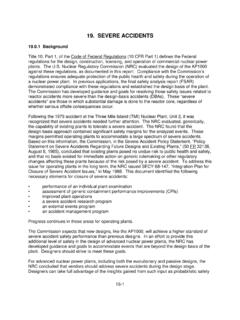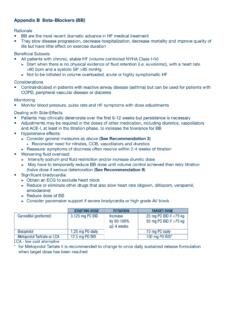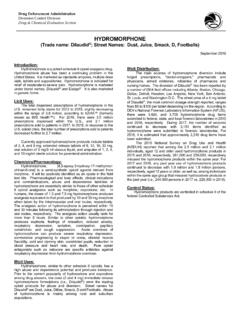Transcription of TOXIC WASTES AND RACE - Nuclear Regulatory …
1 TOXIC WASTES AND RACEIn The United StatesA National Report on the Racial and Socio-EconomicCharacterist!cs of Communitieswith Hazardous waste SitesCOMMISSION FOR RACIAL JUSTICEU nited Church of Christ 1957 Exhibit 13 COVER DESIGN KEY:Shaded areas represent cc'inties where the Black and/orHispanic percentage of the population is greater than theirrespective national percentages.(Black percentage of the population in : 12 percent)(Hispanic percentage of the population in : 6 percent)Dark areas represent counties where the Black and/orHispanic percentage of the population is greater than theirrespective national percentages and where five or moreuncontrolled TOXIC waste sites are : Bureau of the Environmental Protection AgencyCopies of map on cover are available upon copies of this report.
2 Are available for for postage and inquiries regarding this report should be directed to:Commission for Racial JusticeUnited Church of Christ105 Madison AvenueNew York. New York 10016212-683-5656 Copyright 'c 1987 by the United Church of ChristCommission for Racial Justice. All rights in the United States of PREFACEThe Commission for Racial Justice of the milllon-member United Churchof Christ is pleased to release this report. TOXIC WASTES and Race in theUnited States: -A National Report on the Racial and Socio-EconomicCharacteristics of Communities with Hazardous waste Sites. We believe thatthis report is of utmost importance, not only to racial and ethniccommunities, but also to the nation as a whole. It is the first nationalreport to comprehensively document the presence of hazardious WASTES InrIaciil iima ethnic communities throughout the United 1982.
3 -we have investigated and challenged the alarming presence oftoxic substances in residential areas across the country. Theseinvestigations led us to examine the relationship between the treatment,storage and disposal of hazardous WASTES ,and the issue of January 1986, two cross-sectional studies were initiated, utilizingappropriate statistical techniques, to determine the extent to whichAfrican Americans, Hispanic Americans, Asian Americans, Pacific Islanders,Native Americans and others are exposed to hazardous WASTES In theircommunities. These were the first national studies to examine thissubject. One study focused on commercial hazardous waste facilities: theother focused on uncontrolled TOXIC waste sites. The data presented inthis report are the result of both of the data exhibited in this report has never before been compiledfor public review.
4 It Is our hope that this Information will be used byall persons committed to racial and environmental justice to challenge whatwe believe to be an Insidious form of racism. We share a common definitionof racism with the National Council of Churches Racial Justice WorkingGroup:Racism Is racial prejudice plus power. Racism Is theIntentional or unintentional use of power to Isolate,separate and exploit others. This use of power Is based ona belief in superior racial origin, Identity or supposedracial characteristics. flacism confers certain privilegeson and defends the dominant group, which in turn sustainsixand perpetuates racism. Both consciously and unconsciously,racism is enforced and maintained by the legal, cultural,religious, educational, economic, political, environmentaland military institutions of societies.
5 Racism Is morethan just a personal attitude; it is the institutionalizedform of that report is Intended to better enable the victims of this Insidious formof racism not only to become more aware of the problem, but also toparticipate in the. formulation of viable strategies. Too often AfricanAmericans and other racial and ethnic peoples are the victims of racism butare relegated to a defensive or reactive response. rather than a are releasing this report in the interests of the millions of people wholive in potentially health-threatening situations. In particular, we callattention to the fact that race is a major factor related to the presenceof hazardous WASTES in residential communities throughout the United Chur'ch of Christ, through the Commission for Racial Justice, hasmade a long-term commitment to seeing that justice is done across the linesof race.
6 As a national church-based civil rights agency, we believe thatthe time has come for all church and civil rights organizations to takethis issue realize that involvement in this type of research is a departure fromour traditional protest methodology. However, if we are to advance, ourstruggle in the future, it will depend largely on the availability oftimely and reliable information. We believe this data should be utilizedby federal, state and municipal governments to prevent hazardous wastesfrom becoming an even greater national problem. No residential community,regardless of race, should be left defenseless in the midst of thismounting are grateful to the Special Appeals Committee of the Executive Councilof the United Church of Christ for providing funding from the Neighbors InNeed Offering for the studies and for this report.
7 Special r- "gnitionshould be given to Charles Lee, Director. Special Project ToxicInjustice of the Commission for Racial justice, who was responsible forcoordinating the publication of TOXIC WASTES and Race in the United F. Chavis DirectorxEXECUTIVE SUMMARYR ecently, there has been concern over the problem ofhazardous WASTES . This concern has been focused upon the adverseenvironmental and health effects of TOXIC chemicals and other hazardoussubstances emanating from operating hazardous waste treatment, storage anddisposal facilities as well as thousands of ahandoned waste sites. Effortsto address this issue. however, have largely ignored the specific concernsof African Americans, Hispanic Americans. Asian Americans, PacificIslanders and Native Americans. Unfortunately, racial and ethnic Americansare far more likely to be unknowing victims of exposure to such policies ushered in by the Reagan Administration signaled areduction of domestic programs to monitor the environment and protectpublic health.
8 Reduction of efforts to protect public health Isespecially disturbing in light of the many citizens who unknowingly may beexposed to substances emanating from hazardous waste sites. According to aDecember 1986 General Accounting Office (GAO) report. the Protection Agency (EPA) "does not know if it has Identified90 percent of the potentially hazardous WASTES or only 10 percent."Issues surrounding the siting of hazardous waste facilities in racial andethnic communities gained national prominence in 1982. The Commission forRacial Justice joined ranks with residents of predominantly Black and poorWarren County, North Carolina in opposing the establishment of apolychlorinated biphenyl (PCB) disposal landfill. This oppositionculminated in a nonviolent civil disobedience campaign and more than 500arrests.
9 As a result of the protests in Warren County, the GAO studied theracial and socio-economic status of communities surrounding four landfillsin southeastern United States. it found that Blacks comprised the majorityof the population in three of the four communities to the Warren County. demonstrations, racial and ethnic communitieshad been marginally Involved with issues of hazardous WASTES . One reasonfor this can be traced to the nature of the environmental movement whichhas historically been white middle and upper-class in Its does not mean, however, that racial and ethnic communities do not carexiabout the quality of their environment and Its effect on their the course of the Commission for Racial Justice's involvementwith issues or hazardous WASTES and environmental pollution, we have foundnumerous grassroots racial and ethnic groups actively seeking to deal withthis problem In their and ethnic.
10 Communities have been and continue to be beset bypoverty, unemployment and problems related to poor housingi education andhealth. These communities cannot afford the luxury of being primarilyconcerned about the quality of their environment when confronted by aplethora of pressing problems related to their day-to-day survival. Withinthis context, racial and ethnic communities become particularly vulnerableto those who advocate the siting a hazardous waste facility as an avenuefor employment and economic development. Thus, proposals that economicIncentives be offered to mitigate local opposition to the establishment ofnew hazardous waste facilities raise disturbing social policy observed these developments, the United Church of Christ Commissionfo" Racial Justice decided, in 1986, to conduct extensive research on therelationship between the location of sites containing hazardous WASTES andthe racial and socio-economic.
